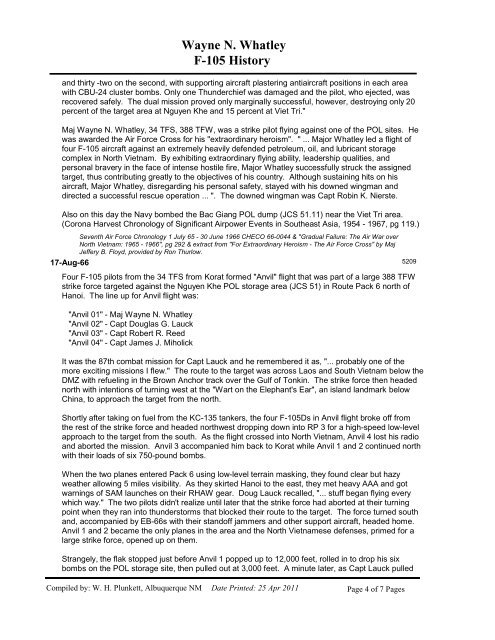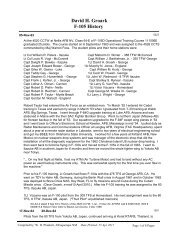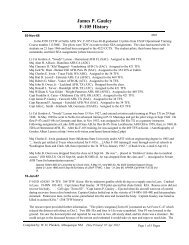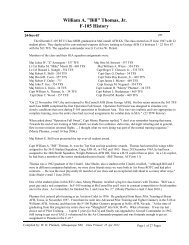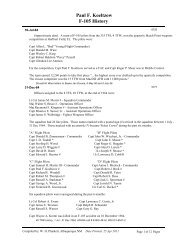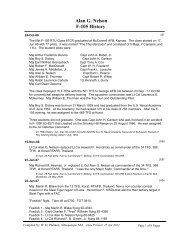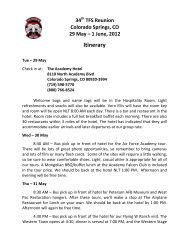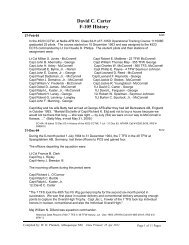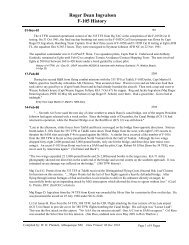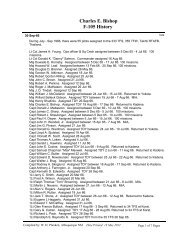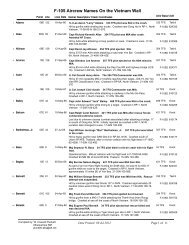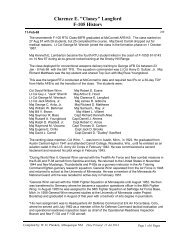Wayne N. Whatley F-105 History - 34th Tactical Fighter Squadron ...
Wayne N. Whatley F-105 History - 34th Tactical Fighter Squadron ...
Wayne N. Whatley F-105 History - 34th Tactical Fighter Squadron ...
You also want an ePaper? Increase the reach of your titles
YUMPU automatically turns print PDFs into web optimized ePapers that Google loves.
<strong>Wayne</strong> N. <strong>Whatley</strong><br />
F-<strong>105</strong> <strong>History</strong><br />
and thirty -two on the second, with supporting aircraft plastering antiaircraft positions in each area<br />
with CBU-24 cluster bombs. Only one Thunderchief was damaged and the pilot, who ejected, was<br />
recovered safely. The dual mission proved only marginally successful, however, destroying only 20<br />
percent of the target area at Nguyen Khe and 15 percent at Viet Tri."<br />
Maj <strong>Wayne</strong> N. <strong>Whatley</strong>, 34 TFS, 388 TFW, was a strike pilot flying against one of the POL sites. He<br />
was awarded the Air Force Cross for his "extraordinary heroism". " ... Major <strong>Whatley</strong> led a flight of<br />
four F-<strong>105</strong> aircraft against an extremely heavily defended petroleum, oil, and lubricant storage<br />
complex in North Vietnam. By exhibiting extraordinary flying ability, leadership qualities, and<br />
personal bravery in the face of intense hostile fire, Major <strong>Whatley</strong> successfully struck the assigned<br />
target, thus contributing greatly to the objectives of his country. Although sustaining hits on his<br />
aircraft, Major <strong>Whatley</strong>, disregarding his personal safety, stayed with his downed wingman and<br />
directed a successful rescue operation ... ". The downed wingman was Capt Robin K. Nierste.<br />
Also on this day the Navy bombed the Bac Giang POL dump (JCS 51.11) near the Viet Tri area.<br />
(Corona Harvest Chronology of Significant Airpower Events in Southeast Asia, 1954 - 1967, pg 119.)<br />
Seventh Air Force Chronology 1 July 65 - 30 June 1966 CHECO 66-0044 & "Gradual Failure: The Air War over<br />
North Vietnam: 1965 - 1966", pg 292 & extract from "For Extraordinary Heroism - The Air Force Cross" by Maj<br />
Jeffery B. Floyd, provided by Ron Thurlow.<br />
17-Aug-66<br />
Four F-<strong>105</strong> pilots from the 34 TFS from Korat formed "Anvil" flight that was part of a large 388 TFW<br />
strike force targeted against the Nguyen Khe POL storage area (JCS 51) in Route Pack 6 north of<br />
Hanoi. The line up for Anvil flight was:<br />
"Anvil 01" - Maj <strong>Wayne</strong> N. <strong>Whatley</strong><br />
"Anvil 02" - Capt Douglas G. Lauck<br />
"Anvil 03" - Capt Robert R. Reed<br />
"Anvil 04" - Capt James J. Miholick<br />
It was the 87th combat mission for Capt Lauck and he remembered it as, "... probably one of the<br />
more exciting missions I flew." The route to the target was across Laos and South Vietnam below the<br />
DMZ with refueling in the Brown Anchor track over the Gulf of Tonkin. The strike force then headed<br />
north with intentions of turning west at the "Wart on the Elephant's Ear", an island landmark below<br />
China, to approach the target from the north.<br />
Shortly after taking on fuel from the KC-135 tankers, the four F-<strong>105</strong>Ds in Anvil flight broke off from<br />
the rest of the strike force and headed northwest dropping down into RP 3 for a high-speed low-level<br />
approach to the target from the south. As the flight crossed into North Vietnam, Anvil 4 lost his radio<br />
and aborted the mission. Anvil 3 accompanied him back to Korat while Anvil 1 and 2 continued north<br />
with their loads of six 750-pound bombs.<br />
When the two planes entered Pack 6 using low-level terrain masking, they found clear but hazy<br />
weather allowing 5 miles visibility. As they skirted Hanoi to the east, they met heavy AAA and got<br />
warnings of SAM launches on their RHAW gear. Doug Lauck recalled, "... stuff began flying every<br />
which way." The two pilots didn't realize until later that the strike force had aborted at their turning<br />
point when they ran into thunderstorms that blocked their route to the target. The force turned south<br />
and, accompanied by EB-66s with their standoff jammers and other support aircraft, headed home.<br />
Anvil 1 and 2 became the only planes in the area and the North Vietnamese defenses, primed for a<br />
large strike force, opened up on them.<br />
Strangely, the flak stopped just before Anvil 1 popped up to 12,000 feet, rolled in to drop his six<br />
bombs on the POL storage site, then pulled out at 3,000 feet. A minute later, as Capt Lauck pulled<br />
Compiled by: W. H. Plunkett, Albuquerque NM Date Printed: 25 Apr 2011<br />
Page 4 of 7 Pages<br />
5209


